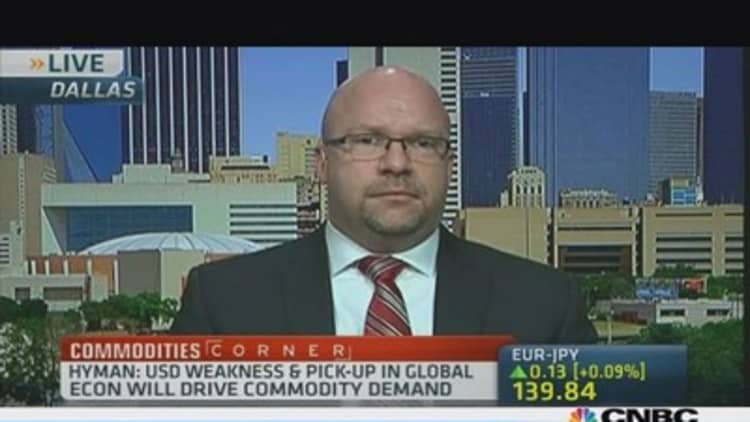Winter's chilling effect on the economy is sending gold bears into hibernation.
Gold has been rallying and broke the key level of $1,300 an ounce this week for first time since early November. On Friday, Comex gold futures for April delivery added 1.4 percent.
"I think the bears are temporarily hibernating," said George Gero of RBC. "What they haven't realized is the asset allocators came zooming back. Look at the tonnage going into GLD and IAU. That's what's underpinning the market. You've got momentum traders in here. Over $1300, they come in."
Gold futures rose Friday to settle at $1,318.60 per troy ounce, while the SPDR Gold Shares Trust and iShares Gold Trust both rose more than 1 percent. Silver sprang higher with gold, up more than 5 percent. Gold futures are up 4.4 percent for the week.
Gero pointed to an usual market divergence that has occurred this week.
"Usually when the stock market goes down, gold goes up," he said, adding that the two markets' moving in tandem signals a change in direction.
"The other reason is all commodities have been affected by politics and weather," Gero said. "There was a tsunami, and the cold front. Commodities have been underdelivering and so prices have been moving higher—coffee, cocoa, cotton, grains. Some of it's currency-related, with Venezuela and Argentina devaluing. There's enough in the world's headlines to make the investor think about re-entering the gold market."
(Read more: This jobs report should keep Yellen up at night)
Gold began to shine even more after Fed Chair Janet Yellen's testified on Capitol Hill. Saying that weather may be behind December and January's weak jobs reports, she re-emphasized the Fed's commitment to tapering its bond-buying unless there is a significant change in the economy.
"The market is saying, 'Hey, we think there's a possibility that your outlook could materially change,' " said Bart Melek, head of commodities strategy at TD Securities. That has kindled speculation that the Fed will be forced to postpone plans to continue tapering the $65 billion-a- month quantitative easing program.

Lower rates have also helped gold prices.
"It's more a safe haven and the opportunity cost in holding this stuff," Melek said, adding that a lot of the recent move in gold was technical.
(Read more: Street snowed in; traders eye new highs)
"We said once it moves past the 200-day moving average, we would easily see 1,324, and moving toward 1,361. There are certainly technical factors behind these moves," he said. He expects gold to top out at about $1,361 for now. The 200-day is around $1,304.
Gero expects gold to move up to about $1,350 in this move.
(Read more: Gold cracked $1,300—here's what's next)
Though Melek doesn't think the weather will have a lingering effect on the economy, he said the resulting weak data are clearly having an impact on the market.
In a CNBC survey, economists predicted a $50 billion hit to the $16 trillion U.S. economy, or about a third of a percentage point. But they also expect any hit to first-quarter growth to be partially reversed as weather improves.
"I think it would have some effect, but I don't think it is going to permanently damage the U.S. economy," Melek said. "I think we could have a month of a stronger market; 1,361 wouldn't be that surprising.
(Read more: All that snow is dragging US down)
"I'm not sure the bear is dead but maybe just a little bit wounded," he said. "A lot of bears are getting squeezed out and had to cover their positions."
Friday's industrial production was a perfect example of weather-impacted data.
Manufacturing output for January fell 0.8 percent, pushing down overall industrial production, which is the measure of output of manufacturers, utilities and mines. It fell 0.3 percent from the previous month—its first decline since July.
The Fed blamed the manufacturing drop on the weather and said weather also drove a utility production gain of 4.1 percent in January, after a 1.4 percent decrease in December.
(Read more: Gold races above $1,300; set for best week in 6 months)
Economists have been paring their expectations for first-quarter growth.
Forecasters surveyed by the Philadelphia Fed see a drop in economic activity in the first quarter but a pickup in the second, consistent with the idea of a spring rebound. The Philadelphia Fed said the Friday that economists cut their first-quarter growth forecast to 2 percent from 2.5 percent.
—By CNBC's Patti Domm. Follow her on Twitter @pattidomm.


